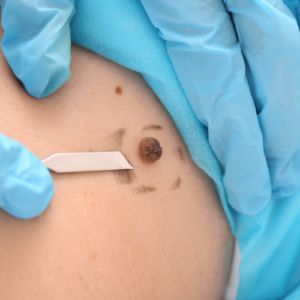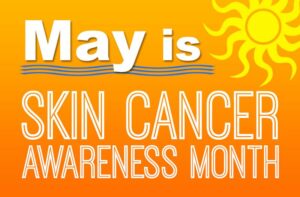Melanoma & Skin Cancer Awareness
Skin cancer is a serious and widespread medical condition, affecting millions of people across the globe. Among the different types of skin cancer, melanoma is considered the most dangerous, with a high potential for metastasis and mortality. Nodular melanoma, in particular, is a rare but highly aggressive subtype of melanoma that can pose significant challenges to both patients and healthcare providers. With its rapid growth and minimal surface changes, nodular melanoma often goes unnoticed until it reaches an advanced stage, making early detection crucial for successful treatment.

In this article, we’ll discuss the complexities of nodular melanoma, examining its causes, symptoms, and impact on patient’s physical and mental health. Additionally, we will explore the different treatment options available, including the role of health insurance in covering the costs of treatment. Finally, we will highlight the importance of raising awareness about nodular melanoma and the need for increased vigilance in skin cancer prevention and early detection.

Understanding Nodular Melanoma
Nodular melanoma is a unique type of skin cancer that differs from other types in its appearance and growth pattern. As mentioned earlier, it often appears as a fast-growing, raised bump that can be black, brown, or dark blue in color. The lesion may have a smooth surface or a scaly texture and can range in size from a few millimeters to several centimeters. Unlike other types of melanoma, nodular melanoma lacks the typical features that make it easier to detect, such as irregular borders or color variations.

Nodular melanoma can develop on any part of the body, but it is more common in areas that receive a lot of sun exposure, such as the face, neck, and legs. This is because exposure to UV radiation is a significant risk factor for developing skin cancer, including nodular melanoma. Other factors that increase the risk of developing nodular melanoma include having fair skin, a history of sunburns, a family history of melanoma, and a weakened immune system.
While the exact causes of nodular melanoma are still unknown, researchers have identified several genetic mutations that can increase the risk of developing this type of skin cancer. These mutations can affect various pathways that regulate cell growth and division, making cells more likely to become cancerous. However, more research is needed to fully understand the underlying causes of nodular melanoma and to develop effective prevention and treatment strategies.
The Importance of Early Detection
Early detection is crucial when it comes to nodular melanoma, as it can significantly impact the patient’s prognosis and quality of life. In fact, research has shown that the five-year survival rate for nodular melanoma drops dramatically if the cancer has spread to other parts of the body.

However, when nodular melanoma is detected in its early stages, it can often be treated successfully with surgery or other minimally invasive procedures, resulting in a better chance of a full recovery.
To detect nodular melanoma early, it’s essential to perform regular self-examinations for skin cancer and schedule regular skin cancer screenings with a dermatologist. During a skin cancer screening, a dermatologist will examine the patient’s skin for any suspicious moles or lesions and may take a biopsy to determine if the lesion is cancerous.
Patients should also be aware of the symptoms of nodular melanoma, including a new, raised bump on the skin that grows rapidly, a change in the color or texture of an existing mole, or bleeding or itching in a mole or bump. If any of these symptoms are present, it is important to seek medical attention promptly.
Late detection or misdiagnosis of nodular melanoma can result in more severe consequences, including metastasis, which is the spread of cancer to other parts of the body. Metastatic nodular melanoma is more difficult to treat and has a lower survival rate.
Therefore, it’s important to be proactive in monitoring one’s skin and seeking medical attention if any unusual changes or symptoms are present. By catching nodular melanoma early, patients can increase their chances of successful treatment and better outcomes.
Physical and Mental Consequences of Nodular Melanoma

Nodular melanoma can have a range of physical and mental consequences that can significantly impact a patient’s quality of life. The physical effects of nodular melanoma may include scarring and disfigurement, particularly if surgery is required to remove the cancerous tissue. Depending on the extent of the surgery, patients may experience pain, swelling, nerve damage, or lymphedema, which is the buildup of fluid in the body’s tissues.
In addition to the physical effects, nodular melanoma can also have a significant impact on a patient’s mental health. A diagnosis of cancer can be a significant source of stress and anxiety, particularly if the cancer has progressed to an advanced stage. Patients may experience a range of emotions, including fear, anger, and depression, as they come to terms with the diagnosis and the challenges that lie ahead. The emotional toll of nodular melanoma can be challenging for both patients and their families.
It is important for patients with nodular melanoma to seek support from family, friends, or mental health professionals to manage the emotional aspect of the condition. This can include counseling, therapy, or support groups that can help patients cope with their diagnosis, manage their emotions, and develop strategies for self-care. By addressing the physical and emotional consequences of nodular melanoma, patients can improve their overall well-being and quality of life.
Treatment Options for Nodular Melanoma
Several treatment options are available for nodular melanoma, depending on the stage of the disease. Let us discuss them one by one:
Surgery
Surgery is the primary treatment for nodular melanoma. The goal of surgery is to remove the tumor and surrounding tissue to prevent the cancer from spreading to other parts of the body. There are several surgical options available, including:
Wide excision: This procedure involves removing the tumor and a surrounding area of healthy tissue. The amount of healthy tissue removed depends on the size and location of the tumor.
Mohs surgery: This technique is used to remove tumors on the face or other areas where the preservation of healthy tissue is critical. During Mohs surgery, layers of skin are removed one at a time and examined under a microscope until no cancer cells are detected.
Sentinel lymph node biopsy: This procedure involves removing the lymph node closest to the tumor to determine if the cancer has spread.
The type of surgery recommended will depend on the size and location of the tumor, as well as the individual’s overall health.
Radiation Therapy
After surgery, radiation therapy is frequently employed to eliminate any residual cancer cells. In instances where nodular melanoma cannot be surgically removed or has progressed to advanced stages, radiation therapy can be utilized as the primary treatment option. This method employs high-energy radiation to eradicate cancer cells and can be administered externally or internally, depending on the tumor’s location.
Nonetheless, radiation therapy can have adverse effects, including skin irritation, fatigue, and nausea. These side effects, however, are typically short-lived and can be controlled with medication or other treatments.
Chemotherapy
Chemotherapy involves using drugs to kill cancer cells. It’s often used for advanced-stage nodular melanoma that has spread to other parts of the body. Chemotherapy may be given orally or through an IV, depending on the specific drugs used. Chemotherapy can have side effects, including nausea, vomiting, hair loss, and fatigue. However, newer chemotherapy drugs are better tolerated and have fewer side effects than older drugs.
Immunotherapy
Immunotherapy is a newer treatment option that works by boosting the body’s immune system to help it fight cancer. Immunotherapy drugs work by blocking proteins that prevent the immune system from attacking cancer cells. This allows the immune system to recognize and destroy cancer cells.
Immunotherapy can have side effects, including fatigue, fever, and rash. However, these side effects are usually less severe than those associated with chemotherapy.
Palliative Care
Palliative care is focused on managing the symptoms and improving the quality of life for individuals with advanced-stage nodular melanoma. Palliative care may include medications to manage pain, swelling, or other symptoms associated with the disease. It may also include physical therapy or other interventions to improve mobility and quality of life.
Palliative care is an essential aspect of treatment for individuals with advanced-stage nodular melanoma. It can help them manage their symptoms and maintain their quality of life.
Each treatment option has its potential benefits and drawbacks. For example, surgery is typically the most effective treatment for early-stage nodular melanoma, but it can result in scarring or nerve damage. In contrast, chemotherapy may have more severe side effects but may be more effective for advanced-stage disease.
It is crucial to follow a treatment plan and work with a medical team to monitor progress and manage any side effects.
May – Skin Cancer Awareness Month

May is Skin Cancer Awareness Month, and it’s important to recognize that skin cancer is America’s most common cancer. However, skin cancer is also one of the most preventable cancers. By spreading awareness of the dangers of unprotected sun exposure and encouraging people to check their skin for warning signs, we can save lives.
One way to get involved is through the #SkinCheckChallenge, a healthy social media trend that involves checking your skin from head to toe, posting a photo or video of your skin check with the hashtag #SkinCheckChallenge, and inviting two friends to do it also. This is a fun and easy way to start a wave of skin checks around the world to help save lives.
Another way to get involved is by sharing skin cancer facts, prevention guidelines, and early detection content on social media using the hashtag #SharetheFacts. You can also tell your own #ThisIsSkinCancer story on Facebook, Twitter, or Instagram, or create a crowdfunding page to raise funds for skin cancer research and prevention programs. There is also a Skin Cancer Toolkit, learn more here
It’s important to remember that skin cancer is the cancer you can see, yet it often goes undetected in the early stages. That’s why The Big See campaign was launched, to empower people to get to know their skin, check themselves in the mirror, and keep these three simple words in mind: NEW, CHANGING, or UNUSUAL. Learn more at the Skin Cancer Foundation here
The Role of Health Insurance
Health insurance can play a crucial role in the management and treatment of nodular melanoma. Many health insurance plans cover the cost of cancer treatment, including surgery, chemotherapy, and radiation therapy. However, the coverage and costs can vary significantly depending on the type of insurance plan and the specific treatment required.
Patients should review their insurance coverage carefully and discuss any concerns or questions with their medical team. Additionally, patients may need to consider additional costs related to treatment, such as transportation or medication expenses.
It’s also important to note that health insurance isn’t just limited to cancer treatment. Health insurance can also provide coverage for routine medical check-ups, prescription medications, and emergency medical services.
If you’re considering purchasing health insurance, it’s important to research different plans and obtain a health insurance quote to find the best coverage for your needs and budget. Having health insurance can provide peace of mind and financial protection in the event of unexpected medical expenses.
Conclusion
Nodular melanoma is a serious type of skin cancer that requires early detection and prompt treatment for better outcomes. Understanding the causes, symptoms, and available treatment options can help patients and their families make informed decisions and manage the physical and emotional effects of the condition. It’s also essential to review and understand insurance coverage to ensure access to necessary treatment and support. However, non-Melanoma skintype conditions can be treated quite easily, pain-free, and quickly using CRYOPEN technology. Learn more about the types of lesions and how it works here





